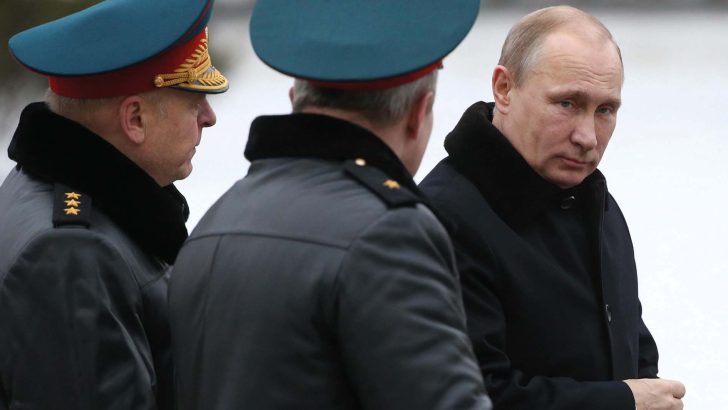The key to the link between past and present, as is so often the case, lies in a book.
President Vladimir Putin’s earlier life was spent in the ranks of the Russia secret service. The distorted moral vision of that organisation has shaped his views of people, life and the world. For that state service from Tsarist era, through the decades of Lenin and Stalin, down to today is a continuum. It is the same creature in different jackets.
In their long history of subterfuge, one of the great crimes of the Russian secret service was the creation and circulation of a notorious anti-Semitic publication that later delighted the national socialists.
I cannot imagine that many people these days have actually read The Protocols of the Learned Elders of Zion, one of the most influential pamphlets in modern times, which was directly responsible for the murders of the Holocaust and the continuing flow of anti-Semitic nonsense around the world, and the disruption and displacement of populations in Eastern Europe down to the 1940s.
The material was first printed in Russian in 1903 as part of a book called The Great in the Little: Anti-Christ as a coming possibility, by an Ordinary Person, written by a ‘Professor’ Sergei Nilus, a Russian Orthodox crank obsessed with the apocalypse. The protocols, alleged to be the records of the discussions of an active secret political group bent on world conquest, were however by another hand.
Historical
Soon because they were seen as an historical document, the protocols were separately reprinted and were soon in wide circulation around the world. Two English language versions appeared in 1919, one heavily promoted by H. A. Gwynne, the editor of the then influential Morning Post, at that time the newspaper of the conservative English elite (for which reason Michael Collins read it first thing every day). Gwynne believed it was a true document, as did many others from the Tsar to Rudyard Kipling.
The idea being promoted was that there existed a Jewish conspiracy to control the world. There is no need to go into the details here, as they are still trotted out on the internet today. It was intended originally to discredit the leaders of Russia’s Jews. None of these promoters knew the origin of the document. The story of the protocols was a complicated one. But a couple of years later the truth was revealed in a very curious way.
The plot had its convolutions: but at the very heart of it was Colonel Rachkovsky, the head of the foreign branch of the Russian secret service. He invented the concept, which was carried out for him, largely by two ‘useful idiots’. One was Nilus. The other, and the actual author of the protocols, was a young man named Golowinsky, who adapted a long forgotten French text to a new and different purpose.
The fabricated nature of the protocols was brought to the attention of the world in 1921 by the Anglo-Irish journalist Phillip Graves – The Times of London correspondent in intrigue riddled post-war Constantinople.
(One of the well-known Graves family of Ballylickey in West Cork, he was the son of the poet Alfred Percival Graves, and the older half-brother of the poet and novelist Robert Graves.)
It was in Constantinople that Graves secretly received from an exiled White Russian a battered copy of a little book. It had lost its first pages so there was no indication of who the author was. On the coverless back there was a single word: JOLI.
Graves was familiar with the ramblings of the protocols and the text he read was that of the protocols. And yet curiously not protocols, for there were many alterations. Whatever it really was the booklet was clearly the basis of the notorious Protocols.
But who or what was ‘JOLI’? The name might be a clue. Graves realised he had a major story of world importance on his hands. He sent it off at once to the editors in London.
A few hours in the great library of the British museum revealed the booklet was in fact a political squib aimed at the regime of Napoleon III. It had been composed for anti-Masonic purposes by a French lawyer named Maurice Joly in 1864. He was jailed for his temerity, and the authorities ordered the destruction of the edition. A few copies, however, escaped the vigilance of the French secret police.
In the copy in Bibliotheque Nationale in Paris the pages carried various pencil marks. These were later seen to be significant: for they had been made by the editor preparing the version for Col. Rachkovsky.
Inclusion
The text had in fact been prepared for its inclusion in Nilus’ book by a young man called Golowinsky, working to a direct commission from Colonel Rachkovsy. He basically rewrote Joly’s text making it overtly anti-Semitic rather than anti-Masonic. He made little secret of his work among his small group of eminent friends in Paris, such as Princess Catherine Radziwill, who later on related his conversations to other reporters.
This breakthrough story was published by The Times with long parallel extracts of the texts, over several days in mid-August 1921. This should have killed the matter dead. But it is hard to kill a lie. Further exposures with further details of the crime had to follow especially when the then-emerging Adolf Hitler took up the matter. He believed these muck-raking activities by journalists of the ‘bourgeois’ press merely showed that the Protocols were indeed true.
In the present day, in Russia’s lies, then lies about the lies, and yet further lies about the original lies, we see the same secret service mentality of both Col. Rachkovsky and of Mr Putin’s sometime colleagues, now his own fawning functionaries in action, working away as well as they did in the days of the Tsar.


 Peter Costello
Peter Costello
